ECU Citroen JUMPY MULTISPACE 2014 2.G Owner's Manual
[x] Cancel search | Manufacturer: CITROEN, Model Year: 2014, Model line: JUMPY MULTISPACE, Model: Citroen JUMPY MULTISPACE 2014 2.GPages: 260, PDF Size: 13.41 MB
Page 10 of 260
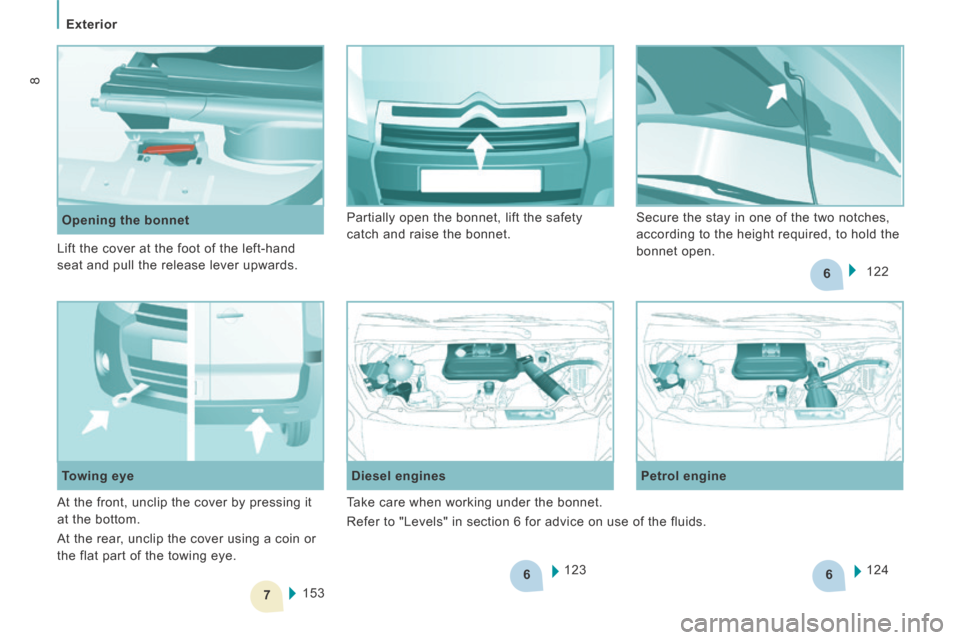
6
7
6
6
Exterior
8
JUMPY-ATLANTE-VP_EN_CHAP01_PRISE EN MAIN_ED01-2014
Opening the bonnet 123
Diesel engines
Petrol engine
124
153
Towing eye 122
Partially open the bonnet, lift the safety
catch and raise the bonnet.
Secure the stay in one of the two notches,
according to the height required, to hold the
bonnet open.
Lift the cover at the foot of the left-hand
seat and pull the release lever upwards.
At the front, unclip the cover by pressing it
at the bottom.
At the rear, unclip the cover using a coin or
the flat part of the towing eye. Take care when working under the bonnet.
Refer to "Levels" in section 6 for advice on use of the fluids.
Page 28 of 260

26
Access
JUMPY-ATLANTE-VP_EN_CHAP02_PRET A PARTIR_ED01-2014
HINGED REAR DOORS
When parked with the rear
doors open to 90°, the doors
mask the rear lamps.
To signal your position to road
users travelling in the same
direction who may not have
noticed that you have stopped,
use a warning triangle or any
other device stipulated by the
legislation and regulations of
your country.
TAILGATE
From the outside
The two hinged doors open to 90°.
To open, pull the handle towards you then
pull the lever to open the left-hand door.
To close, start with the left-hand door then
close the right-hand door.
Opening to 180°
A retractable check strap system permits
extension of the opening from 90° to 180°.
Disengage the check strap towards you
when the door is partially open.
The check strap will re-attach automatically
on closing.
From the outside
If fitted on your vehicle, locking/unlocking is
via the remote control.
To open, press the control then raise the
tailgate.
A strap is provided to secure the tailgate in
the upper position.
From inside
Emergency control
In the event of a central unlocking operating
fault, this permits unlocking of the tailgate
from the inside.
Fold the rear seats to gain access to
the lock.
Insert a small screwdriver in this opening to
unlock the tailgate.
Page 87 of 260
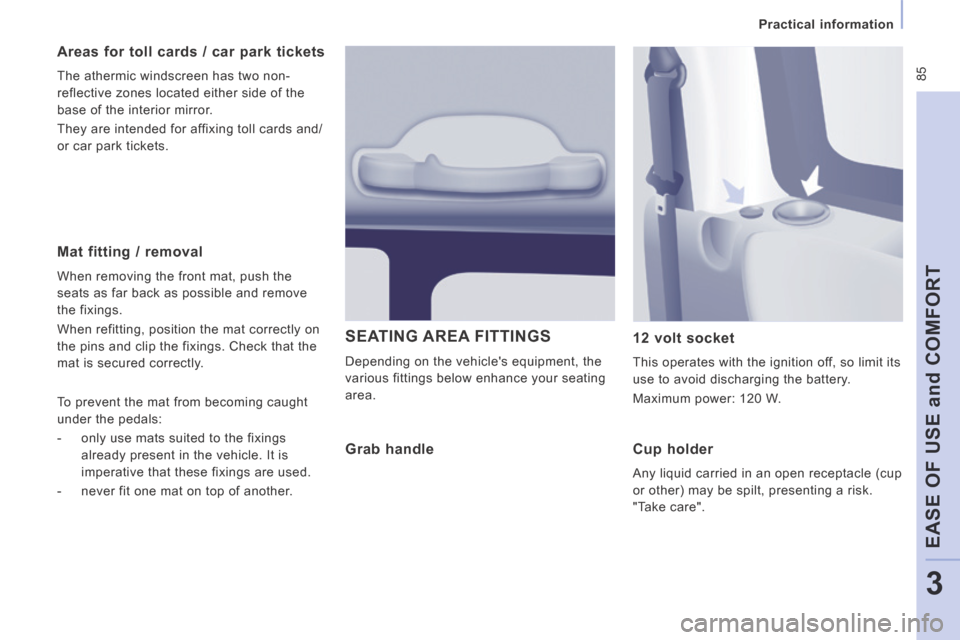
85
Practical information
EASE OF USE and COMFORT
3
JUMPY-ATLANTE-VP_EN_CHAP03_ERGONOMIE ET CONFORT_ED01-2014
Mat fitting / removal
When removing the front mat, push the
seats as far back as possible and remove
the fixings.
When refitting, position the mat correctly on
the pins and clip the fixings. Check that the
mat is secured correctly.
Areas for toll cards / car park tickets
The athermic windscreen has two non-
reflective zones located either side of the
base of the interior mirror.
They are intended for affixing toll cards and/
or car park tickets.
SEATING AREA FITTINGS
Depending on the vehicle's equipment, the
various fittings below enhance your seating
area.
12 volt socket
This operates with the ignition off, so limit its
use to avoid discharging the battery.
Maximum power: 120 W.
To prevent the mat from becoming caught
under the pedals:
- only use mats suited to the fixings
already present in the vehicle. It is
imperative that these fixings are used.
- never fit one mat on top of another.
Grab handle Cup holder
Any liquid carried in an open receptacle (cup
or other) may be spilt, presenting a risk.
"Take care".
Page 89 of 260
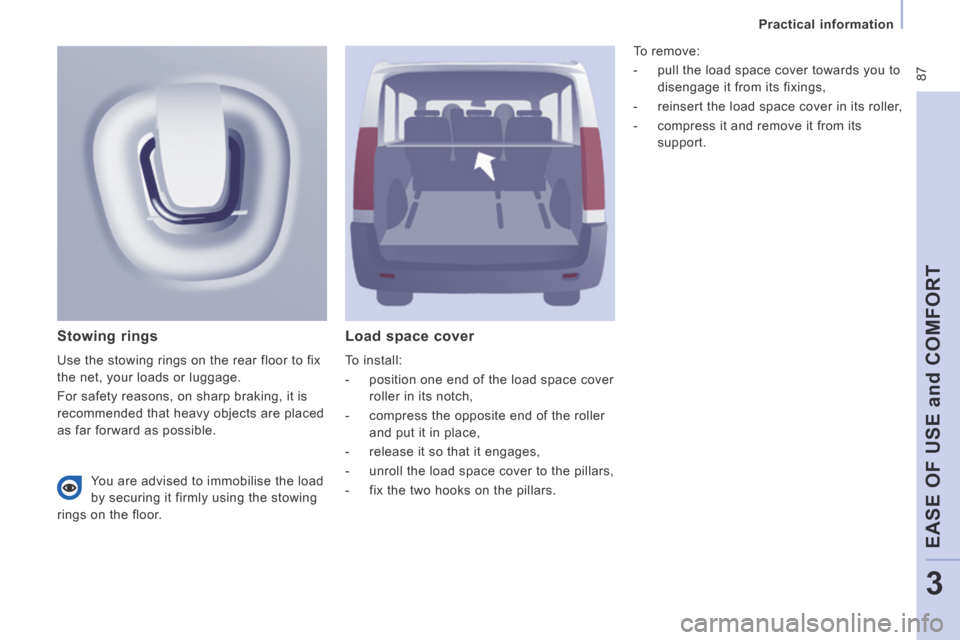
87
Practical information
EASE OF USE and COMFORT
3
JUMPY-ATLANTE-VP_EN_CHAP03_ERGONOMIE ET CONFORT_ED01-2014
Load space cover
To install:
- position one end of the load space cover roller in its notch,
- compress the opposite end of the roller and put it in place,
- release it so that it engages,
- unroll the load space cover to the pillars,
- fix the two hooks on the pillars.
Stowing rings
Use the stowing rings on the rear floor to fix
the net, your loads or luggage.
For safety reasons, on sharp braking, it is
recommended that heavy objects are placed
as far forward as possible. To remove:
- pull the load space cover towards you to
disengage it from its fixings,
- reinsert the load space cover in its roller,
- compress it and remove it from its support.
You are advised to immobilise the load
by securing it firmly using the stowing
rings on the floor.
Page 94 of 260

92
Mirrors and windows
JUMPY-ATLANTE-VP_EN_CHAP03_ERGONOMIE ET CONFORT_ED01-2014
Manual rear view mirror
The rear view mirror has two positions:
- day (normal),
- night (anti-dazzle).
To change from one to the other, push or
pull the lever on the lower edge of the mirror.
SURVEILLANCE MIRROR
This mirror, placed on top of the central
mirror, enables the driver or front passenger
to observe all the rear seats.
Fitted on its own ball joint, it's manual
adjustment is simple and provides a view of
the rear interior of the vehicle.
It can also be adjusted for improved visibility
during manoeuvres or when overtaking.
REAR WINDOWS
2nd row side windows
If fitted on your vehicle, the 2nd row side
windows can be opened.
Squeeze the two controls then move the
window sideways. 4 notches are available.
While driving, the window must be closed or
secured on one of the 4 notches.
3rd row rear quarter lights
These are fixed.
Page 96 of 260
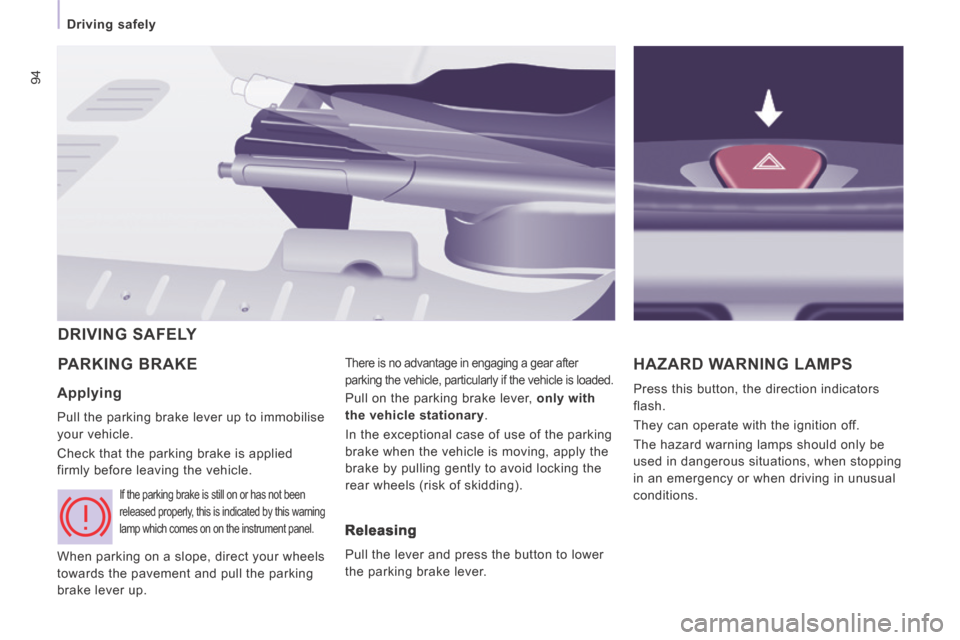
94
Driving safely
JUMPY-ATLANTE-VP_EN_CHAP04_SECURITE_ED01-2014
PARKING BRAKE There is no advantage in engaging a gear after
parking the vehicle, particularly if the vehicle is loaded. HAZARD WARNING LAMPS
Press this button, the direction indicators
flash.
They can operate with the ignition off.
The hazard warning lamps should only be
used in dangerous situations, when stopping
in an emergency or when driving in unusual
conditions.
DRIVING SAFELY
Applying
Pull the parking brake lever up to immobilise
your vehicle.
Check that the parking brake is applied
firmly before leaving the vehicle.
If the parking brake is still on or has not been
released properly, this is indicated by this warning
lamp which comes on on the instrument panel.
Pull on the parking brake lever, only with
the vehicle stationary .
In the exceptional case of use of the parking
brake when the vehicle is moving, apply the
brake by pulling gently to avoid locking the
rear wheels (risk of skidding).
When parking on a slope, direct your wheels
towards the pavement and pull the parking
brake lever up.
Releasing
Pull the lever and press the button to lower
the parking brake lever.
Page 97 of 260

95
Parking sensors
SAFETY
4
JUMPY-ATLANTE-VP_EN_CHAP04_SECURITE_ED01-2014
The audible and/or visual rear parking
sensor system consists of four proximity
sensors, installed in the rear bumper. The
sensors detect any obstacle which enters
the field: person, vehicle, tree, fence, behind
the vehicle during the manoeuvre.
Certain objects detected at the beginning of
the manoeuvre will no longer be detected
at the end of the manoeuvre due to the
blind spots between and below the sensors.
Examples: stake, roadworks cone or
pavement post.
Engage reverse gear
An audible signal confirms the activation of
the system by engaging reverse gear.
The proximity information is indicated by an
audible signal which becomes more rapid as
the vehicle approaches the obstacle. When
the distance between the rear of the vehicle
and the obstacle is less than approximately
thirty centimetres, the audible signal
becomes continuous.
Activation / Deactivation
REAR PARKING SENSORS
Display in the screen You can activate or deactivate the
system by pressing this button.
The activation or deactivation of
the system is stored when the
vehicle stops.
Malfunction
In the event of a malfunction, when reverse
gear is engaged the LED in the button
comes on, accompanied by an audible
signal and a message in the screen. Contact
a CITROËN dealer or a qualified workshop.
Good practice
In bad weather or in winter, ensure that the
sensors are not covered with mud, ice or
snow.
The system will be deactivated automatically
if a trailer is being towed or if a bicycle
carrier is fitted (vehicle fitted with a
towbar or bicycle carrier recommended by
CITROËN).
The parking assistance cannot, in any
circumstances, take the place of the
vigilance and responsibility of the driver.
Stop the assistance
Change to neutral.
Page 98 of 260

ABS
ABS96
Driving safely
JUMPY-ATLANTE-VP_EN_CHAP04_SECURITE_ED01-2014
HORN
Press the centre of the steering wheel.
ANTI-LOCK BRAKING SYSTEM (ABS - EBFD)
The ABS and EBFD (electronic brake force
distribution) systems improve the stability
and manoeuvrability of your vehicle on
braking, in particular on poor or slippery
surfaces.
The ABS prevents locking of the wheels,
the EBFD provides control of the braking
pressure wheel by wheel.
Good practice
The anti-lock braking system comes into
operation automatically when there is a risk
of wheel lock. It does not reduce the braking
distance.
On very slippery surfaces (ice, oil, etc...)
the ABS may increase the braking distance.
When braking in an emergency, do not
hesitate to press the brake pedal firmly,
without releasing the pressure, even on a
slippery surface, you will then be able to
continue to manoeuvre the vehicle to avoid
an obstacle.
Normal operation of the ABS may be felt by
slight vibration of the brake pedal.
When changing wheels (tyres and rims),
ensure that these are recommended by
CITROËN. If this warning lamp comes on,
together with the brake and STOP
warning lamps, accompanied by
an audible signal and a message
in the screen, it indicates a malfunction of
the electronic brake force distribution which
could result in a loss of control of the vehicle
on braking.
Stop as soon as it is safe to do so.
EMERGENCY BRAKING ASSISTANCE SYSTEM (EBA)
In an emergency, this system enables the
optimum braking pressure to be reached more
quickly, press the pedal fi rmly without releasing it.
It is triggered by the speed at which the brake
pedal is activated.
This alters the resistance of the brake pedal
under your foot.
If this warning lamp comes on,
accompanied by an audible signal
and a message in the screen, it
indicates a malfunction of the ABS
which could result in a loss of control of the
vehicle on braking. In both cases, contact a CITROËN dealer or
a qualified workshop.
To prolong the operation of the emergency
braking assistance system: keep your foot
on the brake pedal.
Page 99 of 260

OFF
97
Driving safely
SAFETY
4
JUMPY-ATLANTE-VP_EN_CHAP04_SECURITE_ED01-2014
ANTI-SLIP REGULATION (ASR) AND DYNAMIC STABILITY CONTROL (DSC)
These systems are linked and complement
the ABS.
The ASR system is very useful for
maintaining optimum drive and avoiding
losses of control of the vehicle on
acceleration.
The system optimises drive to prevent the
wheels skidding, by acting on the brakes of
the drive wheels and on the engine. It also
allows the directional stability of the vehicle
to be improved on acceleration. If there is a variation between the trajectory
followed by the vehicle and that required by
the driver, the DSC system automatically
acts on the engine and the brake of one
or more wheels, in order to put the vehicle
back on course. Deactivation
In certain exceptional conditions (starting
the vehicle when stuck in mud or snow, or
on loose ground...), it could prove useful
to deactivate the ASR and DSC systems to
make the wheels spin and regain grip.
Operating fault
Good practice
The ASR/DSC systems offer increased
safety during normal driving, but should not
encourage the driver to take risks or to drive
at high speed.
The operation of these systems is assured
only if the recommendations of the
manufacturer regarding the wheels (tyres
and rims), the braking components, the
electronic components and fitting and repair
procedures are observed.
After an impact, have these systems
checked by a CITROËN dealer or a qualified
workshop.
Operation
The warning lamp flashes when
operation of the ASR or DSC is
triggered.
They engage again:
- automatically above 30 mph (50 km/h),
- manually by pressing the button again. When a malfunction of the
systems occurs, the warning
lamp and the LED come on,
accompanied by an audible signal
and a message in the screen.
Contact a CITROËN dealer or a qualified
workshop to have the system checked.
The warning lamp may also come on if the
tyres are under-inflated. Check the pressure
of each tyre.
Use the DSC to hold your course without
attempting to countersteer. - Press the button, located on
the centre console.
- The LED comes on: the ASR and DSC systems no longer
operate.
Page 100 of 260
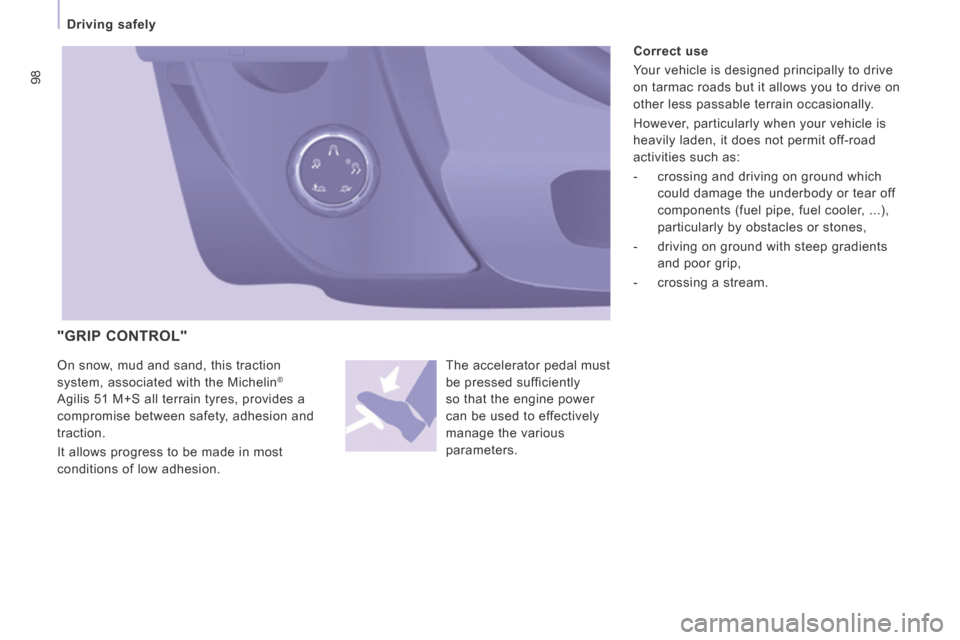
98
Driving safely
JUMPY-ATLANTE-VP_EN_CHAP04_SECURITE_ED01-2014
"GRIP CONTROL"
The accelerator pedal must
be pressed sufficiently
so that the engine power
can be used to effectively
manage the various
parameters.
On snow, mud and sand, this traction
system, associated with the Michelin ®
Agilis 51 M+S all terrain tyres, provides a
compromise between safety, adhesion and
traction.
It allows progress to be made in most
conditions of low adhesion. Correct use
Your vehicle is designed principally to drive
on tarmac roads but it allows you to drive on
other less passable terrain occasionally.
However, particularly when your vehicle is
heavily laden, it does not permit off-road
activities such as:
- crossing and driving on ground which
could damage the underbody or tear off
components (fuel pipe, fuel cooler, ...),
particularly by obstacles or stones,
- driving on ground with steep gradients and poor grip,
- crossing a stream.